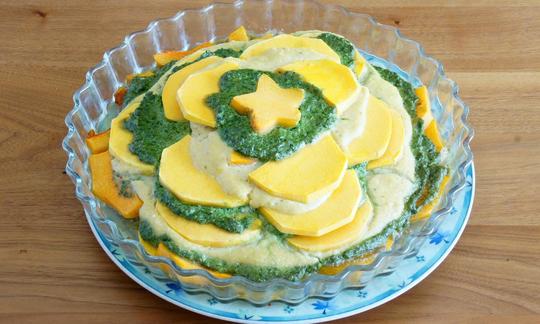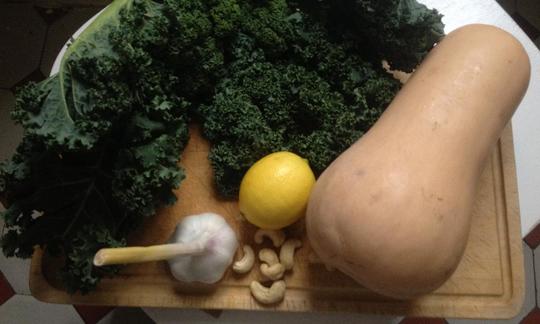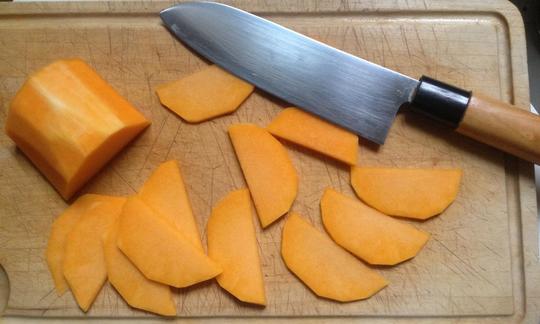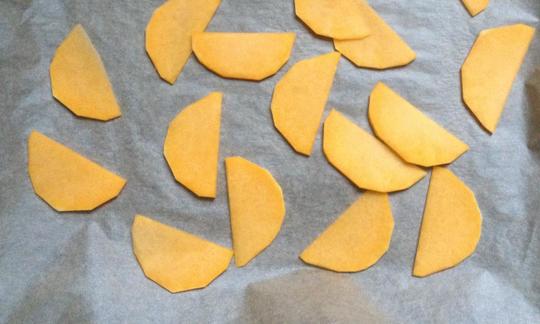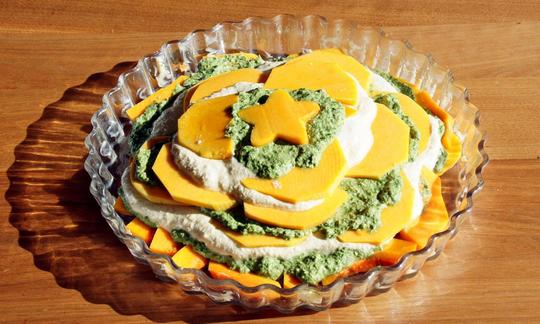Butternut Squash Lasagna with Cashew Cream & Kale Pesto
vegan
Ingredients (for servings, )
| For the cashew cream | |
|---|---|
| 2 cups | Cashew nuts, raw? organic? (cashew nuts) (9.1 oz) |
| 120 ml | Drinking water, raw (organic?) (4.2 oz) |
| ½ tsp | Garlic granules (garlic powder, raw?, organic?) (0.05 oz) |
| 1 tsp | Table salt (table salt, raw?, organic?) (0.21 oz) |
| 1 | Lemons, raw (limes, organic?) (2.0 oz) |
| For the kale pesto | |
| 2 ½ oz | Kale, raw (spring cabbage, organic?) |
| 2 cloves | Garlic (organic?) (0.21 oz) |
| ⅓ cup | Olive oil (cold pressed, raw?, organic?) (2.5 oz) |
| 1 dash | Table salt (table salt, raw?, organic?) (0.01 oz) |
| 1 dash | Black pepper (organic?, raw?) (0.00 oz) |
| For the butternut squash layers | |
| 1 | Butternut squash, raw (pear squash), one butternut squash (30 oz) |
| 2 tsp | Olive oil (cold pressed, raw?, organic?) (0.32 oz) |
| 1 dash | Table salt (table salt, raw?, organic?) (0.01 oz) |
| 1 dash | Black pepper (organic?, raw?) (0.00 oz) |
Equipment
- hand-held blender / immersion blender
- baking pan (springform pan)
- oven
- baking sheet (cookie sheet)
Type of preparation
- bake
- chop or grind
- soak
- blend
- strain
Preparation
For the cashew cream
Soak the cashews in water for at least 2 hours. A maximum of one night is possible.If you choose the shorter soaking time, we recommend that you start preparing the kale pesto before the end of the waiting time. This will shorten the preparation time.
After the soaking process, pour off the water and add the remaining ingredients for the cream. Puree everything finely in a blender.
For the kale pesto
Process all the ingredients needed for the pesto in the food processor until medium-fine. If the processor is struggling, add a little more oil.Pesto is traditionally made in a mortar. Not every food processor is suitable for this purpose, but sometimes a hand blender (stirrer) is sufficient.
For the butternut squash layers
Preheat the oven to 230 °C and line a baking tray with baking paper. Peel the butternut squash, cut off the top and halve. Cut thin, half-moon-shaped slices.The slices should be enough for three layers in a 20 cm pan.
Toss the slices with oil, salt and pepper. Spread them in a single layer on the baking sheet and bake for 20 minutes (until tender).
Allow to cool (approx. 10 minutes) so that you can handle the slices. Reduce oven temperature to 170 °C.
Oil a baking pan or casserole dish and lay out the slices, slightly overlapping. When the first layer is ready, spread the pesto on top. Spread the cashew cream on top. Then add another layer of pumpkin slices and repeat the process, etc.
Bake the lasagne for about 25-30 minutes.
Enjoy!
|
Nutritional Information per person
Convert per 100g
|
2000 kcal | |
|---|---|---|
| Energy | 476 kcal | 23.8% |
| Fat/Lipids | 40 g | 56.6% |
| Saturated Fats | 6.5 g | 32.3% |
| Carbohydrates (inc.dietary fiber) | 25 g | 9.4% |
| Sugars | 8.6 g | 9.6% |
| Fiber | 4.3 g | 17.2% |
| Protein/Albumin | 12 g | 24.1% |
| Cooking Salt (Na:544.0 mg) | 1'382 mg | 57.6% |
| Essential micronutrients with the highest proportions | per person | 2000 kcal | |
|---|---|---|---|
| Vit | Vitamin K | 132 µg | 176.0% |
| Min | Copper, Cu | 1.5 mg | 152.0% |
| Vit | Vitamin A, as RAE | 805 µg | 101.0% |
| Vit | Vitamin C (ascorbic acid) | 56 mg | 70.0% |
| Sodium, Na | 544 mg | 68.0% | |
| Prot | Tryptophan (Trp, W) | 0.16 g | 66.0% |
| Min | Manganese, Mn | 1.3 mg | 64.0% |
| Fat | Linoleic acid; LA; 18:2 omega-6 | 5.6 g | 56.0% |
| Elem | Phosphorus, P | 381 mg | 54.0% |
| Elem | Magnesium, Mg | 194 mg | 52.0% |
Detailed Nutritional Information per Person for this Recipe
The majority of the nutritional information comes from the USDA (US Department of Agriculture). This means that the information for natural products is often incomplete or only given within broader categories, whereas in most cases products made from these have more complete information displayed.
If we take flaxseed, for example, the important essential amino acid ALA (omega-3) is only included in an overarching category whereas for flaxseed oil ALA is listed specifically. In time, we will be able to change this, but it will require a lot of work. An “i” appears behind ingredients that have been adjusted and an explanation appears when you hover over this symbol.
For Erb Muesli, the original calculations resulted in 48 % of the daily requirement of ALA — but with the correction, we see that the muesli actually covers >100 % of the necessary recommendation for the omega-3 fatty acid ALA. Our goal is to eventually be able to compare the nutritional value of our recipes with those that are used in conventional western lifestyles.
| Essential fatty acids | per person | 2000 kcal |
|---|---|---|
| Linoleic acid; LA; 18:2 omega-6 | 5.6 g | 56.0% |
| Alpha-Linolenic acid; ALA; 18:3 omega-3 | 0.26 g | 13.0% |
| Essential amino acids | per person | 2000 kcal |
|---|---|---|
| Tryptophan (Trp, W) | 0.16 g | 66.0% |
| Threonine (Thr, T, irreversibly transaminated) | 0.40 g | 43.0% |
| Valin (Val, V) | 0.65 g | 40.0% |
| Isoleucine (Ile, I) | 0.47 g | 38.0% |
| Leucine (Leu, L) | 0.86 g | 36.0% |
| Phenylalanine (Phe, F) | 0.56 g | 36.0% |
| Lysine (Lys, K, irreversibly transaminated) | 0.58 g | 31.0% |
| Methionine (Met, M) | 0.21 g | 23.0% |
| Vitamins | per person | 2000 kcal |
|---|---|---|
| Vitamin K | 132 µg | 176.0% |
| Vitamin A, as RAE | 805 µg | 101.0% |
| Vitamin C (ascorbic acid) | 56 mg | 70.0% |
| Vitamin B6 (pyridoxine) | 0.46 mg | 33.0% |
| Vitamin B9, B11 (Folate, as the active form of folic acid) | 67 µg | 33.0% |
| Vitamin B1 (Thiamine) | 0.33 mg | 30.0% |
| Vitamin E, as a-TEs | 3.2 mg | 27.0% |
| Vitamin B5 (Pantothenic acid) | 0.77 mg | 13.0% |
| Vitamin B7 (Biotin, ex vitamin H) | 6.0 µg | 12.0% |
| Vitamin B2 (Riboflavin) | 0.12 mg | 9.0% |
| Vitamin B3 (Niacin) | 1.5 mg | 9.0% |
| Essential macroelements (macronutrients) | per person | 2000 kcal |
|---|---|---|
| Sodium, Na | 544 mg | 68.0% |
| Phosphorus, P | 381 mg | 54.0% |
| Magnesium, Mg | 194 mg | 52.0% |
| Potassium, K | 815 mg | 41.0% |
| Calcium, Ca | 83 mg | 10.0% |
| Essential trace elements (micronutrients) | per person | 2000 kcal |
|---|---|---|
| Copper, Cu | 1.5 mg | 152.0% |
| Manganese, Mn | 1.3 mg | 64.0% |
| Zinc, Zn | 3.6 mg | 36.0% |
| Iron, Fe | 4.6 mg | 33.0% |
| Selenium, Se | 11 µg | 20.0% |
| Iod, I (Jod, J) | 2.8 µg | 2.0% |
| Fluorine, F | 18 µg | 1.0% |
For this lasagne with kale pesto & cashew cream we use butternut squash layers instead of pasta sheets, making the recipe vegan and gluten-free
General information about lasagne: Lasagne is available with or without meat, but the pasta is usually not vegan (dairy products) and not gluten-free. Furthermore, lasagne with pasta is not exactly a natural product and therefore not particularly healthy. However, our recipe is: natural, vegan and gluten-free.
The following quotes are from Wikipedia :
Pasta shape: "Lasagne is a very wide type of ribbon pasta that is prepared in a similar way to macaroni. A dish made from wide ribbon pasta that is cooked, tossed in butter and served separately with grated Parmesan is known in culinary terms as Lasagne alla bolognese."
History: "According to a less popular theory, the dish has an English origin: In the Forme of Cury, a collection of recipes from the cooks at the court of King Richard II of England from the 14th century, the dish "loseyns" (pronounced "lasan") is described, which also includes layered pasta sheets baked with cheese."
Etymology: "The Italian lasagna (plural lasagne) ... derives from Ancient Greek τὰ λάσανα, tà lásana, meaning a rack for pots or frying pans. This word was adopted by the Romans as lasanum, meaning "cooking pot". The Italians used the word to refer to the vessel in which what is known as lasagne was prepared - thus the word lasagna refers to the dish itself."
Variations: "Lasagne pasticciate and Lasagne alla casalinga: Lasagne pasticciate or Lasagne alla casalinga, or Pasticcio for short, comes from Bologna and is better known in Germany as Lasagne al forno. The dish consists of several alternating layers of pasta sheets, Ragù alla bolognese (a simple minced meat sauce in a simplified recipe), béchamel sauce and grated Parmesan and is baked in the oven."
"Vincisgrassi: This speciality from the Marche is named after the Austrian Field Marshal Alfred I of Windisch-Graetz - Vincisgrassi is a corruption of this name. It is a casserole consisting of several alternating layers of pasta sheets, a sauce made from lamb, veal brain or veal sweetbreads, poultry liver, wine and tomato, a béchamel sauce and grated Parmesan. The special feature of this preparation lies on the one hand in the pasta dough prepared with dessert wine and on the other hand in the meat sauce seasoned with a little cinnamon."
"In modern cuisine, there are dishes with fish or seafood as well as vegetarian and vegan options. Lasagne is offered as a ready meal in chilled or frozen form."
Composition of the traditional pesto: The traditional pesto alla genovese (Genoese style) consists of basil, pine nuts, garlic and olive oil as well as grated Parmesan or Pecorino. The latter are not vegan. Apart from coarse salt, no spices are added.
The Sicilian variant: The Sicilian variant uses additional dried tomatoes and almonds instead of pine nuts and uses a little less basil.
Pesto alla calabrese: This is a particularly spicy variant from Calabria, in which a higher level of spiciness is achieved with pepper and paprika.
Flavor Expansion: Medium miso paste or yeast flakes The possibly one-dimensional taste of the lasagne can be easily expanded.
Different ways to prepare pesto: Pesto can be prepared in many different ways and originally a mortar was used. Pesto is a specific type of uncooked sauce.
The following quotes are from Wikipedia :
General information: " Pesto (from Italian pestare, "to crush") is a pasty, uncooked sauce that is usually served with pasta in Italian cuisine, especially in the region of origin, trofie or trenette are chosen."
Production: "When making by hand, the creamy mass should be prepared by crushing with a mortar to avoid excessive heat (such as from the high speed of an electrical appliance), which has a detrimental effect on the aroma. A quick approach is important, as oxidation can have a detrimental effect on the smell, taste and appearance."
Trade: "Industrially produced pesto is pasteurized or preserved with preservatives. Fresh, it is sold as a delicacy.
Pesto is a typical example of food design : in the majority of products, expensive ingredients from the classic recipe are completely or partially replaced by cheaper, similar-tasting ingredients and the renowned name is still used, albeit with sometimes misleading illustrations."

